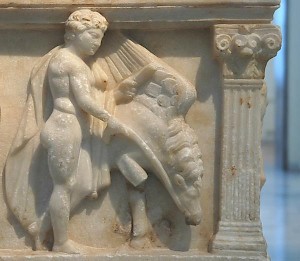Lycia
Q18927Lycia: the mountainous southwest of Turkey.

The landscape of southwestern Turkey, ancient Lycia, is dominated by the fact that in this region, a part of the African Plate collides with the Eurasian Plate. The southern slopes of the Western Taurus rise almost directly from the Mediterranean Sea, making the country almost inaccessible and the coast dangerously rocky. However, over the ages, the little rivers flowing down from the mountain range have laid down fluvial sediments: plains that can be cultivated.
The country, or at least a part of it, is almost certainly identical to the land of the Lukka people, who are mentioned in Hittite sources. There are no known treaties and Lukkan kings are not mentioned, which suggests that these people were not organized as a real state. This is more or less confirmed by the absence of monumental architecture, which suggests that the inhabitants of Lycia were nomads, living in a tribal society. There was no state apparatus.
Officially, the Lukka people were subject to the great king in Hattusa, but just as often, we read about the Lukka as allies of the western enemies of the Hittites. They are also mentioned as pirates, and perhaps this is confirmed by Homer's Iliad, in which the Lycians are mentioned as valiant warriors.note Indeed, it is not impossible that in the Late Bronze Age, Lycian pirates were active in the Aegean Sea, and that Homer remembered this.
In the Iliad, the commanders of the Lycians are Glaucus and Sarpedon. The latter was a son of Zeus and Europa, and a brother of king Minos of Crete, who had sent him into exile. This ancient story was explained by later generations as evidence that the Lycians were, originally, Cretans.

The Iliad contains another story about Lycia's early history: the tale of Bellerophon, who killed a monster called Chimaera. It is a traditional legend about a dragon slayer, and is situated in the eastern part of the country, where future generations knew a place called Chimaera. Although the story from the Iliad may be a much older Lycian myth, Bellerophon's Corinthian ancestry was later taken as evidence for a Greek origin of the Lycians. Iit must be noted, though, that one of the first authors to record this story, the Greek researcher Herodotus of Halicarnassus, adds that the Cretans were no Greeks.note
In reality, the Lycians were autochthonous. Their language, known from a corpus of less than 200 fifth- and fourth-century texts, is not well understood, but is clearly related to Luwian, the dominant language of Anatolia in the Bronze Age. For example, the Luwian storm god Tarkhunt was venerated by the Lycians as Trqqas (who was later identified with Zeus). Another example of religious continuity is the cult of the "mother of the gods" of the ancient Luwians; she was to become identified with Leto, the mother of Apollo and Artemis.